amastroller
喜欢闲逛闲摄而已,无其它不良嗜好Ancient Greece, the cradle of the western civilization, thrived around the Med-Sea from 3000BC to the first century of BC, is known for advances of philosophy, architecture, drama, government, and science.Athens, the enchanting capital of Greece is the most glorious history in the world, has always been a birthplace for civilization. It is the city where democracy was born.Being one of the longest of any city in Europe or the world; Athens has been experienced city-states Classical Age (500-323BC) when it laid the foundations of western civilization, then Middle Ages, Roman Empire, Byzantine Empire, Ottoman Empire, and Athens re-emerged in the 19th century as the capital of the independent Greek state. In 1896, Athens hosted the first modern Olympic Games.
I've been so much fascinated of Greece/Athens since I was in high school. Socrates, Plato, Aristotle, Homer's epic poetry, the Greek Mythology, the Acropolis, the Aegean Sea, .... Visiting Athens is always on of my dreams, and today the dream came true.
At crack of dawn, Carnival Freedom was approaching to the Port of Piraeus, Athens.
 Just it was happened that I caught the cruise ship Sea Diamond (left one in pix) in my picture. 4 days later (April 06, 2007), it sank after running aground near the Greek island of Santorini the previous day.
Just it was happened that I caught the cruise ship Sea Diamond (left one in pix) in my picture. 4 days later (April 06, 2007), it sank after running aground near the Greek island of Santorini the previous day. The beautiful Mikrolimano - a marina moorage of Athens
The beautiful Mikrolimano - a marina moorage of Athens The 2004 Olympic Stadium
The 2004 Olympic Stadium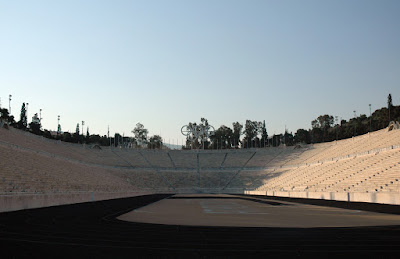 The AcropolisAlthough there are many other acropoleis in Greece as we know, the significance of the Acropolis of Athens is commonly known as The Acropolis without qualification. It is the most important site of the city and constitutes one of the most recognizable monuments of the world.
The AcropolisAlthough there are many other acropoleis in Greece as we know, the significance of the Acropolis of Athens is commonly known as The Acropolis without qualification. It is the most important site of the city and constitutes one of the most recognizable monuments of the world.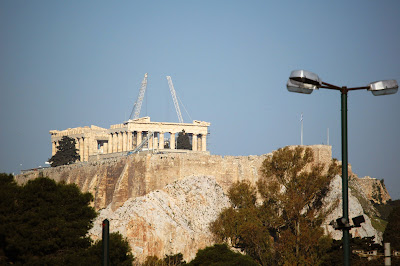
The Acropolis, the site of four of the greatest masterpieces of classical Greek art – the Parthenon, the Propylaea, the Erechtheum and the Temple of Athena Nike, has being illustrated the civilizations, myths and religions that flourished in Greece over a period of more than 1,000 years.The Acropolis Restoration Model (internet picture)
 Part of the east pediment of the Parthenon
Part of the east pediment of the Parthenon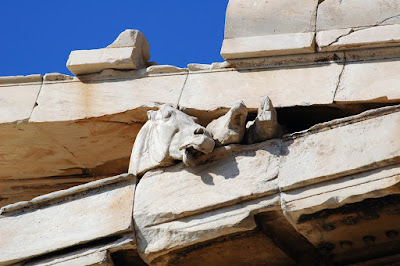 The Erechtheion Located on the north of the hill of the Acropolis, this beautiful temple is an elaborate building in the Ionic style, constructed between 421 and 405 BC. It has a prostasis on the east side, a monumental propylon on the north, and the famous porch of the Caryatids on the south. The main temple was divided into two sections, dedicated to the worship of the two principal gods of Attica, Athena and Poseidon-Erechtheus. A relief frieze, bearing a representation possibly of the birth of Erechtheus, decorated the exterior of the building.
The Erechtheion Located on the north of the hill of the Acropolis, this beautiful temple is an elaborate building in the Ionic style, constructed between 421 and 405 BC. It has a prostasis on the east side, a monumental propylon on the north, and the famous porch of the Caryatids on the south. The main temple was divided into two sections, dedicated to the worship of the two principal gods of Attica, Athena and Poseidon-Erechtheus. A relief frieze, bearing a representation possibly of the birth of Erechtheus, decorated the exterior of the building.  To the south-west is the famous porch with the Caryatids, of which one is exhibited in the British Museum; the remaining are on display in the Acropolis Museum. On the monument itself casts replace the originals.
To the south-west is the famous porch with the Caryatids, of which one is exhibited in the British Museum; the remaining are on display in the Acropolis Museum. On the monument itself casts replace the originals.  The original Cayartides in the Acropolis Museum
The original Cayartides in the Acropolis Museum 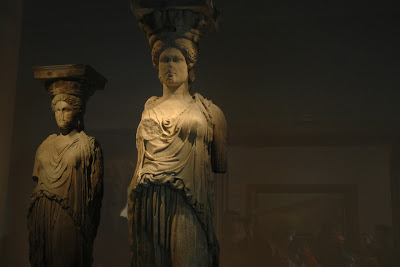 The PropylaeaThe monumental gateway of the Acropolis was sacred area dedicated to Athena, the patron goddess of the city. It was designed by the architect Mnesikles and constructed in 437-432 B.C. It comprises a central building and two lateral wings. The colonnades along the west and east sides had a row of Doric columns while two rows of Ionic columns divided the central corridor into three parts. The walls of the north wing were decorated with painted panels or wall paintings and that is why it was called the "Pinakotheke". The ceiling of the Propylaea had coffers with painted decoration and a perforated sima around the roof. ( internet picture)
The PropylaeaThe monumental gateway of the Acropolis was sacred area dedicated to Athena, the patron goddess of the city. It was designed by the architect Mnesikles and constructed in 437-432 B.C. It comprises a central building and two lateral wings. The colonnades along the west and east sides had a row of Doric columns while two rows of Ionic columns divided the central corridor into three parts. The walls of the north wing were decorated with painted panels or wall paintings and that is why it was called the "Pinakotheke". The ceiling of the Propylaea had coffers with painted decoration and a perforated sima around the roof. ( internet picture)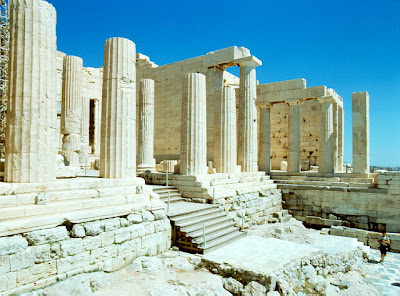 The Temple of Athena Nike (Featherless Victory)Situated southwest of the Entrance, on a rampart protecting the main entrace of the Acropolis, this temple was constructed in ca. 420 B.C. by the architect Kallikrates. It is built in the Ionic order, and it is amphiprostyle with a row of four columns in front of each of its narrow sides. The relief frieze on the upper section of the walls depicts the conference of gods on the east side, and scenes from battles on the other three. A marble parapet decorated with the relief representation of Nikae (Victories), protected the edge of the Bastion on which the temple was erected. (internet picture)
The Temple of Athena Nike (Featherless Victory)Situated southwest of the Entrance, on a rampart protecting the main entrace of the Acropolis, this temple was constructed in ca. 420 B.C. by the architect Kallikrates. It is built in the Ionic order, and it is amphiprostyle with a row of four columns in front of each of its narrow sides. The relief frieze on the upper section of the walls depicts the conference of gods on the east side, and scenes from battles on the other three. A marble parapet decorated with the relief representation of Nikae (Victories), protected the edge of the Bastion on which the temple was erected. (internet picture) The monuments on the Acropolis reflect the successive phases of the city's history. Some of them were converted into Christian churches, houses of the Franks and later on, of the Turks. After the liberation of Athens from the Turks, the protection, restoration and conservation of the monuments was one of the first tasks of the newly-founded Greek state. This major effort is continued until today, with the large-scale restoration and supporting of the monuments, which started in the 1970's and is still in progress. The first excavations on the hill were conducted between 1835 and 1837. More systematic work was carried out in 1885-1890 by Panagiotis Kavvadias. --- http://www.greece-athens.com/
The monuments on the Acropolis reflect the successive phases of the city's history. Some of them were converted into Christian churches, houses of the Franks and later on, of the Turks. After the liberation of Athens from the Turks, the protection, restoration and conservation of the monuments was one of the first tasks of the newly-founded Greek state. This major effort is continued until today, with the large-scale restoration and supporting of the monuments, which started in the 1970's and is still in progress. The first excavations on the hill were conducted between 1835 and 1837. More systematic work was carried out in 1885-1890 by Panagiotis Kavvadias. --- http://www.greece-athens.com/ Copyright © amastroller. All rights reserved.




